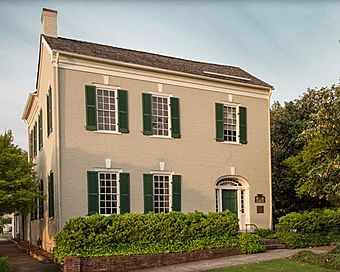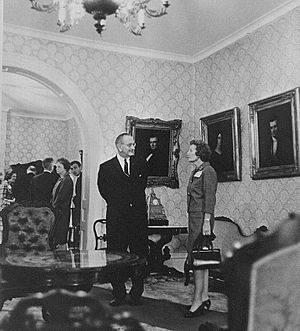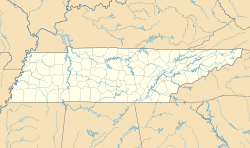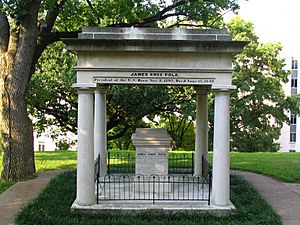- This page was last modified on 17 October 2025, at 10:18. Suggest an edit.
President James K. Polk Home & Museum facts for kids
|
James K. Polk Home
|
|
 |
|
| Location | W. 7th and S. High Sts., Columbia, Tennessee |
|---|---|
| Area | 1.9 acres (0.77 ha) |
| Built | 1816 |
| Architect | Presumed Samuel Polk |
| Architectural style | Federal |
| NRHP reference No. | 66000728 |
| Significant dates | |
| Added to NRHP | October 15, 1966 |
| Designated NHL | July 4, 1961 |
The President James K. Polk Home & Museum is a special place in Columbia, Tennessee. It was once the home of James K. Polk, who was the 11th president of the United States. This house was built in 1816 and is the only private home of President Polk that still exists today. It became a National Historic Landmark in 1961. This means it is a very important historical site in the United States. The museum is open most days for tours, so people can learn about President Polk's life.
About the Polk Home
The James K. Polk Home is located in Columbia, Tennessee. It is a two-story brick building with a unique L-shape. The front of the house has three sections. The main door is set back a bit and has special windows on the sides and above it. The other sections have windows with brick tops. Inside, the house still looks much like it did when it was built. It has been set up to show how people lived back then. There is also a recreated kitchen building outside, like the one that would have been there when Polk lived there.
Who Lived Here?
The house was built in 1816 by Samuel Polk, who was James K. Polk's father. James K. Polk lived in this house for about six years when he was a young adult. He stayed here on and off until 1824. During this time, he studied law in Nashville. After returning to Columbia, he started his own law practice.
Later in 1824, James K. Polk moved to another home nearby with his wife, Sarah Childress Polk. They lived there for most of their lives together. Sadly, that house was destroyed by fire many years ago.
James K. Polk owned this home after his father passed away in 1827. His mother continued to live here until she died in 1852. One of James's younger brothers, William Hawkins Polk, was the last family member to live in the house. His son was the last Polk to own it, until 1871. The house was then owned by several different people. In 1929, President Polk's great-great niece bought the home with help from the state of Tennessee.
How the Museum Started

Lyndon B. Johnson, meeting with a past president of the Polk Association.
After President Polk died, his wife Sarah Polk helped raise her great-niece, Sallie Fall. Sallie lived with Sarah in Nashville for many years. When Sarah passed away, she left many of President Polk's personal items and belongings to Sallie.
Sallie opened her own home in Nashville to the public in the early 1900s. People could come and see the president's belongings that she had inherited. In 1924, Sallie and her daughter, Mrs. Saidee Grant, started the James K. Polk Association. In 1929, Mrs. Grant and the state of Tennessee bought the Polk Home. They then moved all the historical items from Nashville to the museum in Columbia.
President Polk's Tomb
For many years, President Polk and his wife Sarah were buried at the Tennessee State Capitol in Nashville. In 2017, there was a discussion about moving their remains to the Polk Home. The Tennessee Senate voted to approve this idea. The bill went through several steps in the state legislature in 2018. It passed the House of Representatives on April 9, 2018. The governor allowed the bill to become law without his signature. The plan was for the Tennessee Historical Commission and other groups to approve the move before it could be finalized.
See also
- Polk Place, President Polk's later home in Nashville
- List of National Historic Landmarks in Tennessee
- List of residences of presidents of the United States




